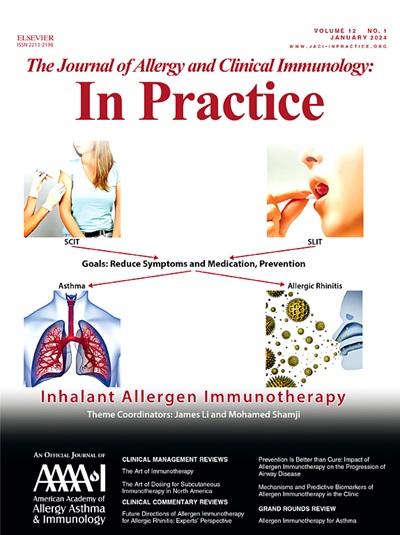Pathogenesis of Chronic Spontaneous Urticaria With or Without Angioedema
IF 6.6
1区 医学
Q1 ALLERGY
Journal of Allergy and Clinical Immunology-In Practice
Pub Date : 2025-09-01
DOI:10.1016/j.jaip.2025.07.025
引用次数: 0
Abstract
Chronic spontaneous urticaria (CSU) is a complex, immune-mediated skin disorder characterized by the appearance of wheals and/or angioedema. Histopathologic analysis reveals skin mast cell degranulation and a perivascular infiltrate composed of lymphocytes, eosinophils, neutrophils, and basophils. Mast cells and basophils are key effector cells in the pathogenesis and severity of CSU, and both cells can be activated by IgE-dependent and independent mechanisms. The pathogenesis of CSU remains incompletely understood, though recent studies have highlighted autoimmune mechanisms involving both IgG and IgE autoantibodies. Two major autoimmune endotypes have emerged: type I (autoallergic), involving IgE autoantibodies to autoantigens like thyroid peroxidase, and type IIb (autoimmune), characterized by IgG autoantibodies targeting IgE or its high-affinity receptor (FcεRI). Recently, it has been found that patients can co-express both endotypes and the disease implications are unclear. Diagnostic tools such as the autologous serum skin test, basophil histamine release assay, and detection of circulating autoantibodies aid in identifying these endotypes but lack standardized assays. In addition to IgE-dependent pathways, recent evidence implicates complement and mas-related G protein–coupled receptor X2 in non–IgE-mediated mast cell activation. Notably, endotype classification has been shown to predict therapeutic response, with type IIb patients often exhibiting lower responsiveness to antihistamines and omalizumab treatments.
慢性自发性荨麻疹伴或不伴血管性水肿的发病机制。
慢性自发性荨麻疹(CSU)是一种复杂的、免疫介导的皮肤疾病,其特征是出现皮疹和/或血管性水肿。组织病理学分析显示皮肤肥大细胞脱颗粒,血管周围浸润淋巴细胞、嗜酸性粒细胞、中性粒细胞和嗜碱性粒细胞。肥大细胞和嗜碱性细胞是CSU发病机制和严重程度的关键效应细胞,这两种细胞都可以通过ige依赖和独立的机制激活。CSU的发病机制仍不完全清楚,尽管最近的研究强调了涉及IgG和IgE自身抗体的自身免疫机制。两种主要的自身免疫性内型已经出现:I型(自身过敏),涉及针对自身抗原(如甲状腺过氧化物酶)的IgE自身抗体;IIb型(自身免疫性),其特征是针对IgE或其高亲和力受体(FcεRI)的IgG自身抗体。最近,研究发现患者可以同时表达两种内型,但其疾病意义尚不清楚。诊断工具,如自体血清皮肤试验(自体皮肤试验)、嗜碱性粒细胞组胺释放试验(BHRA)和循环自身抗体检测,有助于识别这些内型,但缺乏标准化的检测方法。除了ige依赖途径外,最近的证据表明补体和MRGPRX2参与非ige介导的肥大细胞活化。值得注意的是,内型分类已被证明可以预测治疗反应,IIb型患者通常对抗组胺药和omalizumab治疗的反应性较低。
本文章由计算机程序翻译,如有差异,请以英文原文为准。
求助全文
约1分钟内获得全文
求助全文
来源期刊

Journal of Allergy and Clinical Immunology-In Practice
ALLERGYIMMUNOLOGY-IMMUNOLOGY
CiteScore
11.10
自引率
9.60%
发文量
683
审稿时长
50 days
期刊介绍:
JACI: In Practice is an official publication of the American Academy of Allergy, Asthma & Immunology (AAAAI). It is a companion title to The Journal of Allergy and Clinical Immunology, and it aims to provide timely clinical papers, case reports, and management recommendations to clinical allergists and other physicians dealing with allergic and immunologic diseases in their practice. The mission of JACI: In Practice is to offer valid and impactful information that supports evidence-based clinical decisions in the diagnosis and management of asthma, allergies, immunologic conditions, and related diseases.
This journal publishes articles on various conditions treated by allergist-immunologists, including food allergy, respiratory disorders (such as asthma, rhinitis, nasal polyps, sinusitis, cough, ABPA, and hypersensitivity pneumonitis), drug allergy, insect sting allergy, anaphylaxis, dermatologic disorders (such as atopic dermatitis, contact dermatitis, urticaria, angioedema, and HAE), immunodeficiency, autoinflammatory syndromes, eosinophilic disorders, and mast cell disorders.
The focus of the journal is on providing cutting-edge clinical information that practitioners can use in their everyday practice or to acquire new knowledge and skills for the benefit of their patients. However, mechanistic or translational studies without immediate or near future clinical relevance, as well as animal studies, are not within the scope of the journal.
 求助内容:
求助内容: 应助结果提醒方式:
应助结果提醒方式:


